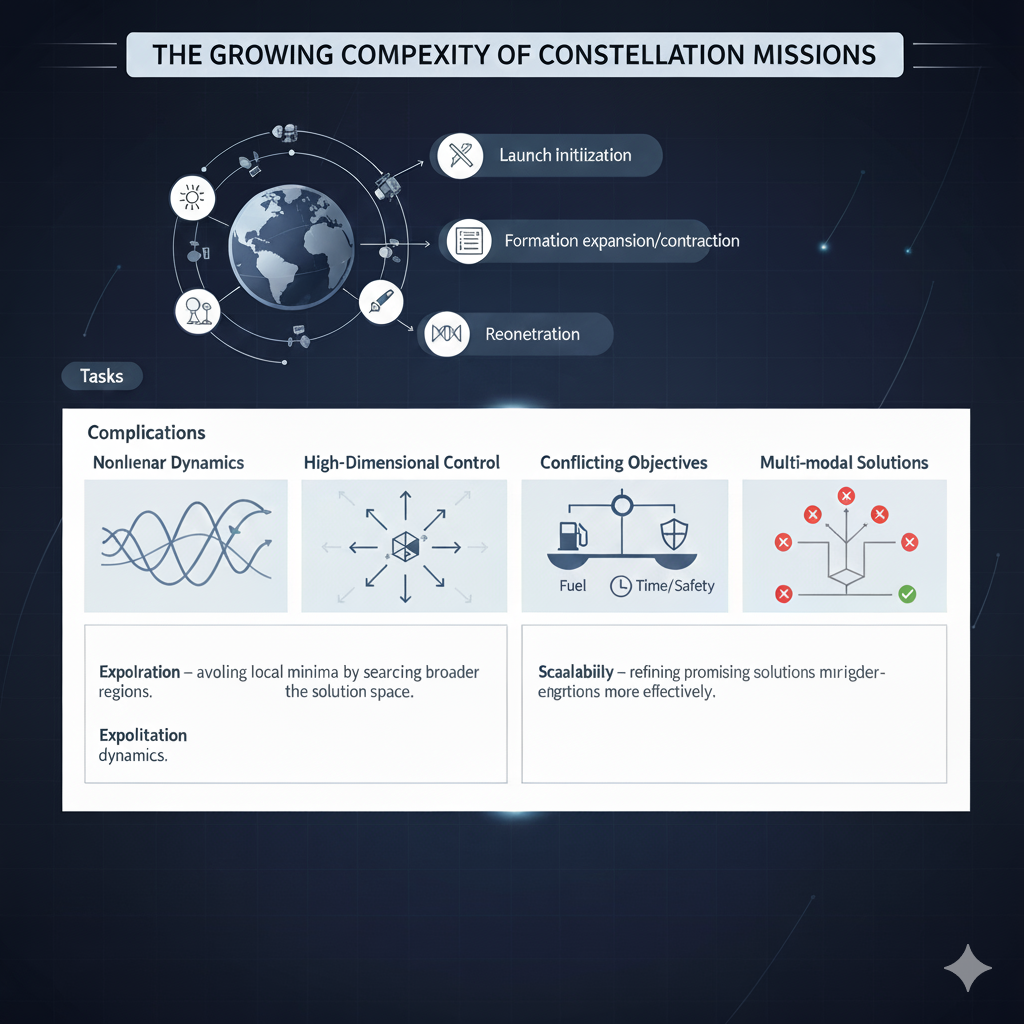The future of space exploration depends on the coordinated operation of multiple spacecraft. Modern missions increasingly deploy fleets of small, low-cost satellites that act in formation to deliver capabilities that would be difficult or prohibitively expensive with a single large spacecraft.
Formation flying missions—such as NASA’s Separated Spacecraft Interferometer and the planned Planet Finder program—highlight the growing reliance on distributed satellite systems. These missions show how constellations can extend scientific reach, improve resilience, and cut costs.
Yet, alongside these benefits comes a central challenge: optimizing the coordinated motion of multiple spacecraft under severe constraints of fuel, time, and safety.
Growing Complexity of Constellation Missions

Coordinating multiple satellites is not just an engineering problem; it is a global optimization challenge.
Typical mission tasks include:
- Initialization after launch
- Precision station-keeping
- Expansion or contraction of the formation
- Coordinated reorientation for new mission phases
Among these, initialization is the most critical. After separation from a launch vehicle, each spacecraft must maneuver into its assigned position without colliding with others. Similar challenges arise when a satellite fails or when the mission’s configuration requirements change.
This process is complicated by:
- Nonlinear dynamics – spacecraft motion follows complex equations with no simple solutions.
- High-dimensional decision spaces – each spacecraft has multiple degrees of freedom to control.
- Conflicting objectives – missions must balance fuel efficiency, maneuver speed, and safety.
- Multi-modal solution spaces – there are many possible solutions, but only a handful meet all constraints.
Even with just a few satellites, the problem becomes computationally intensive and analytically infeasible.
Evolutionary Approaches to Optimization Problems
Traditional optimization techniques, such as gradient-based solvers, are poorly suited for this problem. They tend to converge on local minima, ignoring safer or more efficient solutions elsewhere in the solution space.
Instead, evolutionary algorithms—particularly Genetic Algorithms (GAs)—have become the tools of choice. Inspired by natural evolution, they work by generating a population of possible solutions and iteratively refining them through selection, recombination, and mutation.
Their key strengths include:
- Global search capability, less dependent on initial conditions.
- Population diversity, allowing simultaneous exploration of multiple solutions.
- Adaptability to multi-objective problems, where trade-offs are unavoidable.
GAs have proven effective in many aerospace applications. But in the high-stakes world of constellation missions, their weaknesses remain: premature convergence, heavy parameter tuning, and inefficiency in large-scale, real-time problems.
Maneuver Simplification and Collision Avoidance
To make these problems tractable, researchers often rely on simplified but realistic control models. A common approach is the “bang–coast–bang” thruster profile, where spacecraft accelerate, coast, and decelerate along straight-line trajectories.
For collision avoidance, spacecraft are modeled using bounding spheres, which reduces collision detection to simple distance calculations. This simplification keeps the problem computationally feasible while still representing key safety constraints.
Even with these models, however, the optimization challenge remains formidable.
Toward Quantum-Inspired Optimization (QIO)
As missions grow in size and complexity, a stronger optimization paradigm is required. Quantum-Inspired Optimization (QIO) algorithms extends the principles of evolutionary algorithms with quantum-inspired techniques, delivering better performance in:
- Exploration – avoiding local minima by searching broader regions of the solution space.
- Exploitation – refining promising solutions more effectively.
- Scalability – handling larger constellations and higher-dimensional dynamics.
- Adaptability – responding to live mission updates and changing orbital conditions.
Initial tests with BQPhy’s QIO engine show significant improvements over classical GAs, producing safer, more fuel-efficient, and faster trajectory solutions for constellation initialization.
Implications for the Space Industry
The introduction of QIO is more than a technical upgrade—it is a strategic enabler for next-generation missions. With it, satellite operators can:
- Maximize mission output under tight fuel and time budgets.
- Dynamically adapt to orbital changes, failures, or new mission tasks.
- Enable autonomy in orbital logistics and in-space servicing.
- Strengthen defense capabilities, such as rapid constellation deployment for aerial threat detection.
In short, QIO provides the foundation for making multi-satellite missions safe, efficient, and resilient in an increasingly complex space environment.
Multi-spacecraft trajectory optimization represents one of the hardest problems in aerospace engineering. Traditional methods are insufficient, and even Genetic Algorithms struggle with the demands of real-world missions.
Quantum-Inspired Optimization offers the next step forward. By combining the strengths of evolutionary search with quantum-inspired enhancements, QIO provides a scalable, high-accuracy framework that meets the challenges of modern constellation missions.
As constellation missions grow in complexity, BQP offers a free trial to apply Quantum-Inspired Optimization (QIO) to real mission challenges. Space, aerospace, and defense teams can:
- Optimize multi-satellite trajectories and resource-constrained maneuvers.
- Test scenarios like rapid reconfiguration and fuel-efficient scheduling.
- Compare QIO against classical methods for scalability and solution quality.
Existing customers in mission-critical sectors are already using this trial to prototype solutions beyond the reach of conventional algorithms. This low-risk program helps organizations explore QIO’s potential before full-scale deployment.
FAQ's
What is Quantum-Inspired Optimization (QIO)?
Quantum-Inspired Optimization (QIO) applies principles from quantum computing to evolutionary algorithms, enabling faster, more accurate solutions for complex multi-satellite mission planning.
How does QIO improve multi-satellite missions?
It optimizes trajectories to reduce fuel consumption, shorten maneuver times, and enhance mission safety compared to classical methods.
Can QIO handle large satellite constellations?
Yes, QIO scales efficiently to high-dimensional, multi-satellite scenarios, making it suitable for complex constellation operations.
Is QIO suitable for real-time mission updates?
Absolutely. QIO adapts to dynamic orbital changes, failures, or new mission requirements in real time.
Who benefits from using QIO?
Aerospace, defense, and space operators can leverage QIO for safer, more efficient, and scalable mission-critical planning.
Does QIO require quantum hardware?
No, QIO runs on classical systems while using quantum-inspired principles to achieve advanced optimization performance.



.jpeg)

.png)
.png)


.jpeg)

.svg)
.svg)
.svg)
.svg)